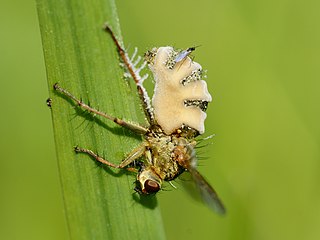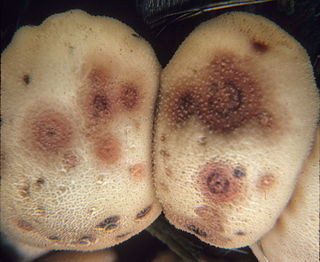
Platanus occidentalis, also known as American sycamore, American planetree, western plane, occidental plane, buttonwood, and water beech, is a species of Platanus native to the eastern and central United States, the mountains of northeastern Mexico, extreme southern Ontario, and extreme southern Quebec. It is usually called sycamore in North America, a name which can refer to other types of trees in other parts of the world. The American sycamore is a long-lived species, typically surviving at least 200 years and likely as long as 500–600 years.

Acer pseudoplatanus, known as the sycamore in the British Isles and as the sycamore maple in the United States, is a species of maple native to Central Europe and Western Asia. It is a large deciduous, broad-leaved tree, tolerant of wind and coastal exposure.

A conidium, sometimes termed an asexual chlamydospore or chlamydoconidium, is an asexual, non-motile spore of a fungus. The word conidium comes from the Ancient Greek word for dust, κόνις (kónis). They are also called mitospores due to the way they are generated through the cellular process of mitosis. They are produced exogenously. The two new haploid cells are genetically identical to the haploid parent, and can develop into new organisms if conditions are favorable, and serve in biological dispersal.

Acer is a genus of trees and shrubs commonly known as maples. The genus is placed in the soapberry family, Sapindaceae, along with lychee and horse chestnut. There are approximately 132 species, most of which are native to Asia, with a number also appearing in Europe, northern Africa, and North America. Only one species, Acer laurinum, extends to the Southern Hemisphere. The type species of the genus is the sycamore maple, Acer pseudoplatanus, the most common maple species in Europe. Maples usually have easily recognizable palmate leaves and distinctive winged fruits. The closest relatives of the maples are the horse chestnuts. Maple syrup is made from the sap of some maple species. It is one of the most common genera of trees in Asia. Many maple species are grown in gardens where they are valued for their autumn colour.

Mycelial cords are linear aggregations of parallel-oriented hyphae. The mature cords are composed of wide, empty vessel hyphae surrounded by narrower sheathing hyphae. Cords may look similar to plant roots, and also frequently have similar functions; hence they are also called rhizomorphs. As well as growing underground or on the surface of trees and other plants, some fungi make mycelial cords which hang in the air from vegetation.

Armillaria luteobubalina, commonly known as the Australian honey fungus, is a species of mushroom in the family Physalacriaceae. Widely distributed in southern Australia, the fungus is responsible for a disease known as Armillaria root rot, a primary cause of Eucalyptus tree death and forest dieback. It is the most pathogenic and widespread of the six Armillaria species found in Australia. The fungus has also been collected in Argentina and Chile. Fruit bodies have cream- to tan-coloured caps that grow up to 10 cm (4 in) in diameter and stems that measure up to 20 cm (8 in) long by 1.5 cm (1 in) thick. The fruit bodies, which appear at the base of infected trees and other woody plants in autumn (March–April), are edible, but require cooking to remove the bitter taste. The fungus is dispersed through spores produced on gills on the underside of the caps, and also by growing vegetatively through the root systems of host trees. The ability of the fungus to spread vegetatively is facilitated by an aerating system that allows it to efficiently diffuse oxygen through rhizomorphs—rootlike structures made of dense masses of hyphae.

Nectria cinnabarina, also known as coral spot, is a plant pathogen that causes cankers on broadleaf trees. This disease is polycyclic and infects trees in the cool temperate regions of the Northern Hemisphere. N. cinnabarina is typically saprophytic, but will act as a weak parasite if presented with an opportunity via wounds in the tree or other stressors that weaken the tree's defense to the disease. A study published in 2011 showed that this complex consists of at least 4 distinct species. There are only a few ways to manage this disease with techniques such as sanitation and pruning away branches that have the cankers. N. cinnabarina is not as significant a problem as other Nectria spp., some of which are the most important pathogens to infect hardwood trees.
Eutypella canker is a plant disease caused by the fungal pathogen Eutypella parasitica. This disease is capable of infecting many species of maple trees and produces a large, distinguishable canker on the main trunk of the tree. Infection and spread of the disease is accomplished with the release of ascospores from perithecia. Therefore, the best way to manage the Eutypella canker is to remove trees that have been infected. If infected, it can decrease the quality of wood cut for lumber and can thus have a negative economic impact.

Mycocentrospora acerina is a deuteromycete fungus that is a plant pathogen.
Monilinia fructigena is a plant pathogen in the fungus kingdom causing a fruit rot of apples, pears, plums, peaches and cherries.

Hymenochaete corrugata is a plant pathogen that causes glue crust in its hosts.

Rhytisma acerinum is a plant pathogen that commonly affects sycamores and maples in late summer and autumn, causing tar spot. Tar spot does not usually have an adverse effect on the trees' long-term health. R. acerinum is an Ascomycete fungus that locally infects the leaves of trees and is a biotrophic parasite. The disease is cosmetic and is therefore usually controlled only with sanitation methods.

Entomophthora muscae is a species of pathogenic fungus in the order Entomophthorales which causes a fatal disease in flies. It can cause epizootic outbreaks of disease in houseflies and has been investigated as a potential biological control agent.

Gulielma Lister was a British botanist and mycologist and was considered an international authority on Mycetozoa.

Auricularia auricula-judae, commonly known as wood ear, jelly ear, or more historically, Jew's ear, is a species of fungus in the order Auriculariales. Basidiocarps are brown, gelatinous, and have a noticeably ear-like shape. They grow on wood, especially elder. The specific epithet is derived from the belief that Judas Iscariot hanged himself from an elder tree.

Epicoccum nigrum is a species of fungus in the phylum Ascomycota. A plant pathogen and endophyte, it is a widespread fungus which produces coloured pigments that can be used as antifungal agents against other pathogenic fungi. The fluorescent stain epicocconone is extracted from it.

Cristulariella depraedans, commonly known as gray mold spot, sycamore leaf spot or bull's eye spot, is a fungal pathogen that affects maple trees and certain other woody and herbaceous species. In maples, the foliage becomes affected by small grey lesions which expand and coalesce, the leaves later wilting and falling from the tree early. The disease seems to be associated with cool wet summers, and epidemic years sometimes occur.
Kathleen Sampson was an English mycologist and plant pathologist, with a focus in herbage crops and cereal diseases. She was a leading authority on smut fungi growing in the British Isles.
Philip Herries Gregory was a British mycologist and phytopathologist. He established an international reputation as a pioneer of aerobiology and a leading expert on the liberation and dispersal of fungal spores and their relation to plant diseases and to human respiratory diseases. In 1957 he was elected to a one-year term as president of the British Mycological Society.
Samuel Paul Wiltshire was an English mycologist and phytopathologist. For the academic year 1943–1944 he was the president of the British Mycological Society.















